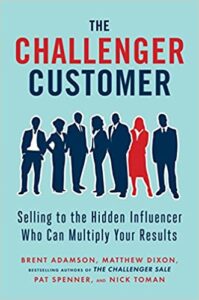In The Challenger Sale, Brent Adamson and Matthew Dixon offered a new B2B sales process through which the best salespeople — known as Challengers — broke through by offering customers unique insights into their problems, tailoring their offerings to specific customer needs, and taking control of the sale rather than being pushed around by customer objections or demands.
Further research by Adamson and Dixon and their colleagues at the consultancy CEB (formerly Corporate Executive Board) revealed that The Challenger Sale had not gone far enough. The book had laid out a method for breaking through to individuals in the customer organization. However, B2B purchasing is now done by committee and not by individuals. Their new book, The Challenger Customer, co-authored with fellow CEB consultants Pat Spenner and Nick Toman, describes the challenges and solutions for selling to a group of buyers with different goals and priorities.
The 5.4
According to the authors, the average B2B sale involves 5.4 individuals. The traditional approach would be to uncover the needs and tailor the product to every individual in order to ensure all “yes’s” to the sale when the group decides. This is not only very time consuming and onerous but inefficient. Extensive research by the authors shows that the more tailoring is attempted for each individual, the lower the quality of the overall sale at the end of the process.
The reason is that sooner or later, the 5.4 colleagues in the customer organization must come together and arrive at a consensus on whether or not to buy. Each arrives with their tailored perspective on the purchase, then discovers that there are 4.4 other different tailored perspectives on the same sale. Discord breaks out, and the sale falls through.
Seven Profiles
How can salespeople overcome the discord and divergent interests of a purchasing group? To find an answer, the authors identified, through thousands of surveys, seven prototypes of B2B buyers. One of the prototypes, the blocker, is just a negative presence in the sale. Three prototypes, the guide who provides information, the friend who enjoys social relationships with suppliers and the climber who looks for the personal benefit of every deal, are what the authors describe as “talkers.” They can talk about their support of the sale, but they are unable to deliver a consensus. The last three buyer prototypes (or “profiles” in the terminology of the authors) are go-getters, teachers, and skeptics, and these are “mobilizers,” the authors write, not talkers. These types of buyers have the capability, through their attributes, to bring their fellow purchase decision-makers to a consensus. Among other attributes, for example, go-getters are ready to champion others’ good ideas, teachers are skilled at convincing others, and skeptics can prepare influential stakeholders for disruptive ideas.
However, as the authors explain, mobilizers are also the challengers of the purchase company. “Go-getters,” the authors write, “will press you because they want to do, teachers because they want to know and skeptics because they want to test.” The best salespeople can meet these challenges, according to the authors, through a similar “teach, tailor and take control” framework first described in The Challenger Sale. They teach by communicating a “commercial insight” — an innovative insight that will help the customer company succeed. They tailor their proposition to the different type of mobilizer. They then coach the mobilizer to tailor the proposition to his or her colleagues — in other words, enabling the mobilizer to take control of the sale.
In The Challenger Customer, the CEB team once again delivers an innovative sales framework based on extensive research and highly relevant to today’s B2B sales challenges.
NOTE: Both The Challenger Sale and The Challenger Customer were named to our list of The 25 Best Sales Books of All Time.





